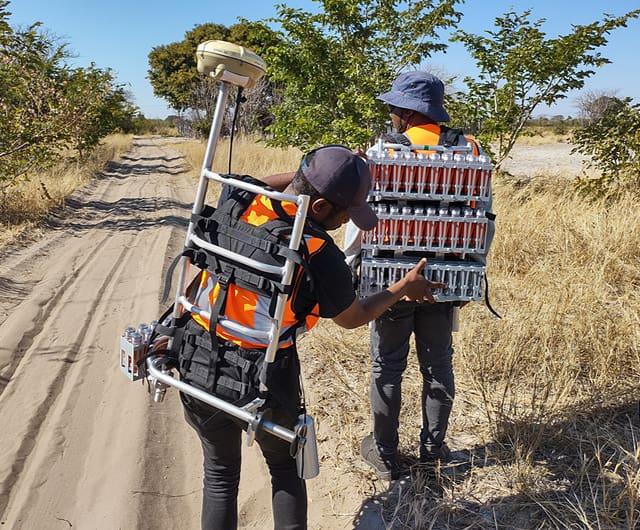
High-density seismic is known to significantly improve knowledge of the subsurface and is, therefore, a crucial tool for de-risking new energy projects and helping companies make more informed decisions where there is geological risk.
Affordable and accessible
STRYDE’s Nodal technology is the smallest, lightest, and most affordable land seismic receiver system in the world and sits at the heart of the company’s unique offering. When coupled with its land seismic, the company’s survey design and data processing services, STRYDE’s offering ensures crucial high-density seismic is affordable and accessible for companies seeking to accelerate their transition to net zero and unlock renewable energy production projects.
The miniature and lightweight traits of the STRYDE Node™ itself allows for seismic data to be acquired in urban, remote, and environmentally sensitive locations and promotes unrivalled efficiencies during subsurface imaging. Use of this technology has saved clients up to 50% on their operational costs, across the energy sector and beyond, when compared to conventional systems for seismic acquisition. This reduction is made up of:
- Savings on survey costs (logistics, transportation, crew size, reduced mobilisation and demobilisation costs etc).
- Less on survey time.
- Considerable savings on equipment costs.
- Reduced line clearing.
Experienced geophysicist and STRYDE’s Product Manager, Tom O’Toole explains, “Our reliable and affordable Nodes can benefit a wide variety of different industries as they are agnostic to the subsurface challenges facing any type of application.”

“At STRYDE, we can help customers in new and emerging industries, who may lack the geophysical expertise in-house, to generate value from high-density seismic data that can propel a project’s future. This is proving especially attractive to companies that are looking to better analyse and understand their prospect, in the most efficient and cost-effective way possible,” O’Toole continues.
Established in 2019, STRYDE is a leading provider of cutting-edge land seismic solutions, backed by a team of experienced experts.
Minimise seismic costs
The STRYDE Node™ is the world’s smallest and lightest Node on the planet, measuring 129 mm x 41 mm and weighing only 150 g. These proportions enable dynamic and efficient transportation and deployment within a diverse range of environments, meaning that they can be utilised in previously unreachable environments. Operating at temperatures ranging from -40° C to +70° C for 28 days of continuous, automated recording, ensures the versatility of the Node even further.
Nick Tranter, Business Development Manager for New Energy at STRYDE comments, “One of the largest barriers to entry for these industries is the high upfront costs and limited project budgets. Geothermal energy production, for example, comes with high development expenses, initially through the drilling of exploration wells.”
“With considerable upfront costs and uncertainty of success restricting the ability of smaller, evolving businesses using seismic to develop their projects, the STRYDE Node™ and supplementary solutions presents an exciting opportunity for companies to minimise seismic costs, de-risk drilling programs, and continuously monitor integrity during operations,” Tranter says.

Increased seismic imaging accessibility
Backed by a wealth of E&P experience, forged in the oil and gas industry, STRYDE and its established reputation are now going further to enhance exploration and monitoring of the subsurface in the renewable energy sector, and beyond. STRYDE’s solutions have increased the accessibility of essential high-quality, high-density seismic imaging in projects for emerging energy industries. This is enabled by the reduced price-point of the technology, providing the means to deploy more Nodes in one field of interest, resulting in a higher definition image uplift.
Non-oil and gas industries such as geothermal, mining, and CCUS require an increasing knowledge of the ground beneath our feet. Using technologies developed for oil and gas provides a chance for the energy sector to transition into more sustainable, regenerative fuel sources.
Tranter adds, “These industries are rapidly adopting STRYDE’s game-changing solution, with 7 CCUS, 10 geothermal, and 3 hydrogen projects having used our technology in the last 12 months.”
Enabling technologies
Technologies like the STRYDE Node™ act as an enabling technology as we strive to reduce the reliance on oil and gas, and further advance the energy industry’s ability to meet net-zero goals.



